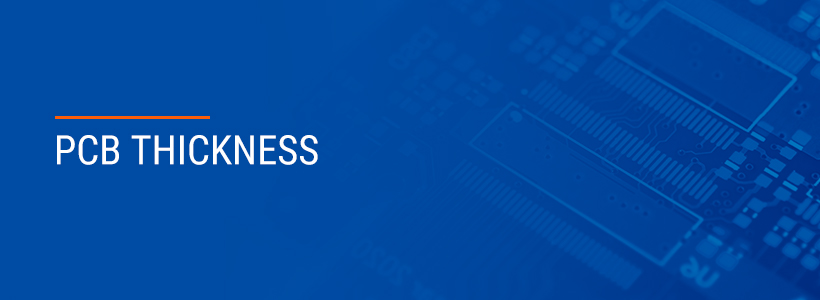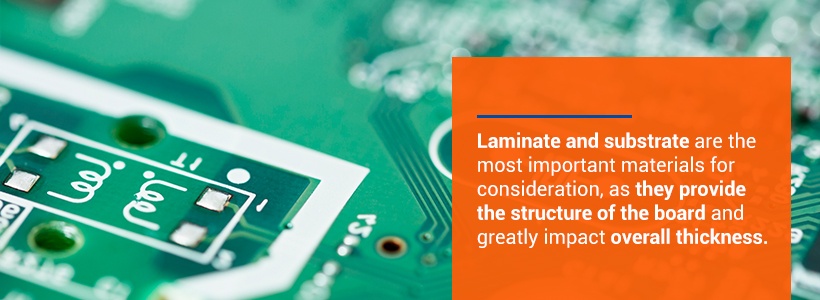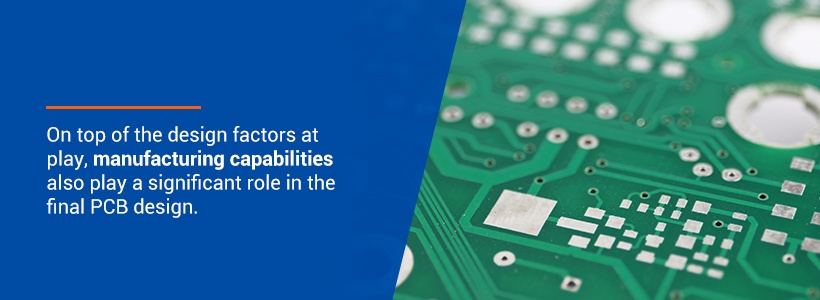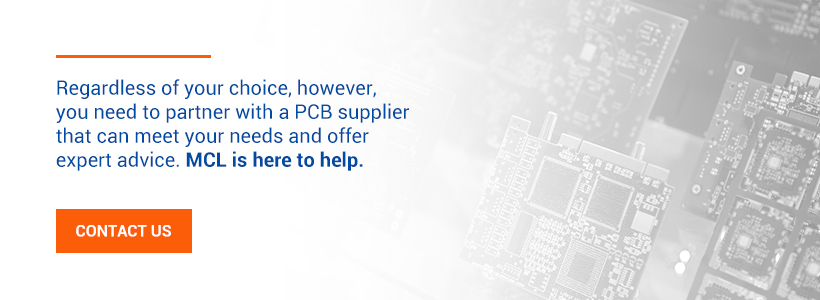Jump To: What Is Standard Thickness for PCBs? | Design Factors That Impact PCB Thickness | Manufacturing Factors That Impact PCB Thickness | 3 Factors to Consider When Choosing PCB Thickness | Request a Free Quote
When referring to dimensions for manufacturing applications, standards are essential to understand and work with. This is especially true for circuit boards. While there is no official standard for PCB thickness, certain sizes are preferred and commonly used among manufacturing companies. These preferred thicknesses are highly recommended to simplify design, effectively leverage manufacturing equipment and minimize costs. However, PCB thickness can vary, and many designers may choose to alter PCB thickness for specific design and manufacturing purposes. Here, we look into what “standard” PCB thickness means and how to determine the PCB thickness for your next project.
What Is Standard PCB Thickness?
MCL’s standard base thickness is 0.062 inches, or 1/16 inch, with a 10% tolerance. This is a very common PCB thickness and is typically considered the industry standard. The reason for this is that 1/16 inch was the size of Bakelite sheets manufactured in the early days of PCB fabrication. While this thickness is the most common, however, there are other common thicknesses seen in PCB manufacturing.
In addition to 0.062-inch boards, 0.031-inch and 0.093-inch boards are commonly used, which meet the needs of more robust or multilayered boards. Boards may have other thicknesses both within and outside of this range, but these are considered the most common thicknesses.
11 Factors That Impact PCB Thickness
While it is important to know industry standard thicknesses, many factors may necessitate a custom board. Depending on these design and manufacturing factors, your board may need to be a non-standard thickness. Two main groups of factors impact PCB thickness — design factors and manufacturing factors. We cover these factors in more detail below and will help you determine how to choose a PCB thickness for your project.
Design Factors That Impact PCB Thickness
Design factors are considered during the PCB design phase. These factors mostly focus on the functionality and purpose of the board, rather than practical considerations necessitated during manufacture, though manufacturing factors hold equal weight. Some of the most important design factors that impact PCB thickness include the following:
1. Size, Weight and Flexibility
Thinner boards are lighter and more flexible than their thicker counterparts but will break more easily due to brittleness. While flex PCBs must be thin to achieve their flexibility, applications that do not require flexibility may benefit from a slightly thicker board for the sake of structural integrity. However, while thicker boards are more rugged, they also carry more weight and take up more space within a device. Both of these features may pose a problem for lightweight applications or devices with limited spatial capacity. The final application of the PCB determines these factors, which must be some of the first parameters to define before beginning PCB design.
2. Copper Thickness
Copper thickness plays a role in the overall thickness of the PCB. The thickness of the copper layer used usually depends on the current that needs to pass through the PCB. Standard copper thickness is roughly 1.4 to 2.8 mils (1 to 2 oz), but this thickness is adjusted according to the unique requirements of the board. The thicker the copper, the thicker the board and the more expensive the board will be due to material needs and processing challenges.
3. Board Materials
The operation and lifetime of a PCB depend on the choice of materials, but these choices also impact board thickness. Typical board fabrication consists of the substrate, laminate, solder mask and silkscreen. Of these, the laminate and substrate are the most important materials for consideration, as they provide the structure of the board and greatly impact overall thickness. The substrate may consist of paper and epoxy resin, glass weave or ceramic depending on the necessary dielectric constant. Laminates, on the other hand, consist of thermoset resin and either paper or cloth layers. Both laminates and substrates come in many options that determine the thermal, mechanical and electrical properties of a circuit board, but also determine the board’s overall thickness.
4. The Number of PCB Layers
The number of PCB layers will, understandably, influence the thickness of the board. While 2-6 layer PCBs thickness may fall within the standard threshold of PCB thickness, 8-layer and up PCBs thickness may not. While manufacturers may be able to use thinner PCB layers to achieve standard thickness, this becomes increasingly impractical as the number of layers increases. Practically speaking, if your design needs more layers, allow for greater PCB thickness. If the design doesn’t require multiple layers but needs to meet certain thickness parameters, reducing the number of layers will be the best choice.
5. Signal Types
PCBs carry a wide range of signal types, which can determine the materials needed for the board and therefore influence the thickness of the board. For example, a board that carries high power signals needs thicker copper and wider traces, which means that it will be significantly thicker than boards operating in a low power environment. High-density boards with more complex signals, however, typically use laser microvias, thin traces and thin high-performance materials, so they are traditionally thinner than other board types.
6. Types of Vias
PCB vias route traces through boards instead of on their surfaces, which is important for creating more compact designs. Many different via types can be used, including:
- Through via
- Micro via
- Blind via
- Buried via
- Via-in-pad
The type and density of vias used will play a factor in how thick the board needs to be to accommodate. For example, micro vias can be used on thinner boards, as they are smaller and intended for high-density connections.
7. Operating Environment
The thickness of the board, as well as the materials it consists of, will affect the conductivity and resistance of a PCB, making different thicknesses desirable in different environments. For example, a thin or flexible board may not be the optimal choice for rugged operating environments. Also, thicker copper traces are less thermally stable with a high current, making them suboptimal for thermally variable or high-current environments. The connectors and components on the PCB are also critical, as these have certain material and performance requirements that may relate to board thickness.
Based on these factors, designers can reasonably assess whether a standard or custom PCB thickness is most desirable. However, the design stage does not end here — the manufacturer must next get involved to discuss what they are capable of and how their capabilities may impact the final PCB design.
Manufacturing Factors That Impact PCB Thickness
On top of the design factors at play, manufacturing capabilities also play a significant role in the final PCB design. including thickness. Some manufacturing factors to consider include the following:
8. Drill Hole Equipment
While designers often pay attention to drill hole size and spacing for performance objectives, drill hole manufacturing processes add a layer of complexity. When drilling through holes of any type, fabricators are limited by the thickness of the board and the diameter and depth capabilities of milling machines and lasers. This limitation is expressed through an aspect ratio, which is the ratio between the depth of the hole and the drill hole diameter. For standard drilling, all manufacturers should be able to achieve a 7:1 aspect ratio. Some manufacturers can achieve a greater aspect ratio, but this must be discussed with the manufacturer before finalizing board design, and usually comes at a higher price. For thicker boards, this means that manufacturers are less able to achieve small-diameter holes.
9. Copper Thickness
Copper traces are created using etching, which is one of the most important steps in PCB manufacturing. Manufacturing processes including etching or plating are dependent on the thickness of the internal copper layer. For this reason, thicker copper layers will impact manufacturability, potentially impacting the design and the cost of the final PCB product.
10. Layer Count
As previously discussed, the more layers on a PCB, the more difficult it is to manufacture to a standard thickness. While specialty manufacturers may be able to create stacked PCBs with thinner layers to accommodate a specific thickness, this capability is not universal and often comes at a greatly increased price. Be sure to discuss your layering needs with the manufacturer before finalizing the design to determine their capabilities and what they can achieve.
11. Depanelization Method
Another manufacturing factor to consider is depanelization. Manufacturers produce PCBs in a large panel containing multiple boards then separate the panels into individual boards. The thickness of the board impacts which depanelization methods may be used — thicker boards may need to be carefully depanelized using scoring, while thinner boards may be routed to create breakaway tabs. Again, work closely with the manufacturer to discuss depanelization methods and requirements and how to alter the PCB design to optimize depanelization.
Discuss all of these manufacturing factors with your manufacturer before completing the final PCB design, as they depend on the manufacturer’s capabilities and costs. If you don’t have this conversation early in the design process, you may find yourself modifying your design or redesigning your layout completely, increasing the costs of your project.
3 Factors to Consider When Choosing PCB Thickness
Sometimes designers will conclude that a standard thickness is best for their application, while others will decide that it is better to customize. While your final design may lead you toward one option or the other, the ending thickness of your PCB will influence many cost-determining factors. Some of the most significant factors to consider when making your final design and manufacturing choices are listed below:
1. Equipment Capabilities
The first consideration is whether your manufacturer has the equipment to manufacture the board thickness you need. The specific areas to address are listed in the “Manufacturing Factors” section above, but this determination should be made early on in the design process. If your application requires certain features that are only achievable using advanced design techniques, it may be best to research manufacturers that can accommodate those needs early. It is important to remember, however, that any advanced techniques will result in higher costs.
2. Turnaround Time
While standard PCB thicknesses require very little adjustment if any, custom thicknesses require time-costly changes. Any custom thicknesses may require manufacturers to change equipment settings and processes to accommodate the unique needs of the design. These adjustments take time, which will delay the onset of manufacturing and potentially increase turnaround time. Any complex design features will further increase the time required for manufacturing. If you choose to pursue a custom PCB thickness, be sure to discuss this with the manufacturer to get an approximate schedule and adjust your delivery estimate accordingly.
3. Additional Cost
Finally, you need to be sure to evaluate whether a custom board will be cost-effective for your business. Standard-thickness boards will not result in the same manufacturing costs and delays as a custom-thickness board, so your business needs to closely assess the cost versus the benefit. While the cost of special materials needed to accommodate a standard thickness may be higher, this cost may be a worthwhile trade-off compared to the changes required to accommodate a custom-thickness board.
Contact Millennium Circuits
There are many choices available in terms of PCB thickness far beyond what is considered “standard.” While using a standard PCB thickness will usually result in faster and less expensive manufacturing, custom thicknesses ensure that you are getting all of the functionality you need for your unique application. Regardless of your choice, however, you need to partner with a PCB supplier that can meet your needs and offer expert advice. MCL is here to help.
Millennium Circuits Limited is a printed circuit board supplier based in Pennsylvania. As a leader in our industry, our goal is to give our customers the best PCBs every time. Regardless of the type or volume of PCBs we are generating, we strive to provide top-notch customer service with products that are engineered expertly, produced well and priced competitively.
MCL serves over 400 customers worldwide with manufacturing locations both domestic and abroad. If you’re interested in learning more about our capabilities or want to discuss PCB thickness options, contact Millennium Circuits today with any questions.






